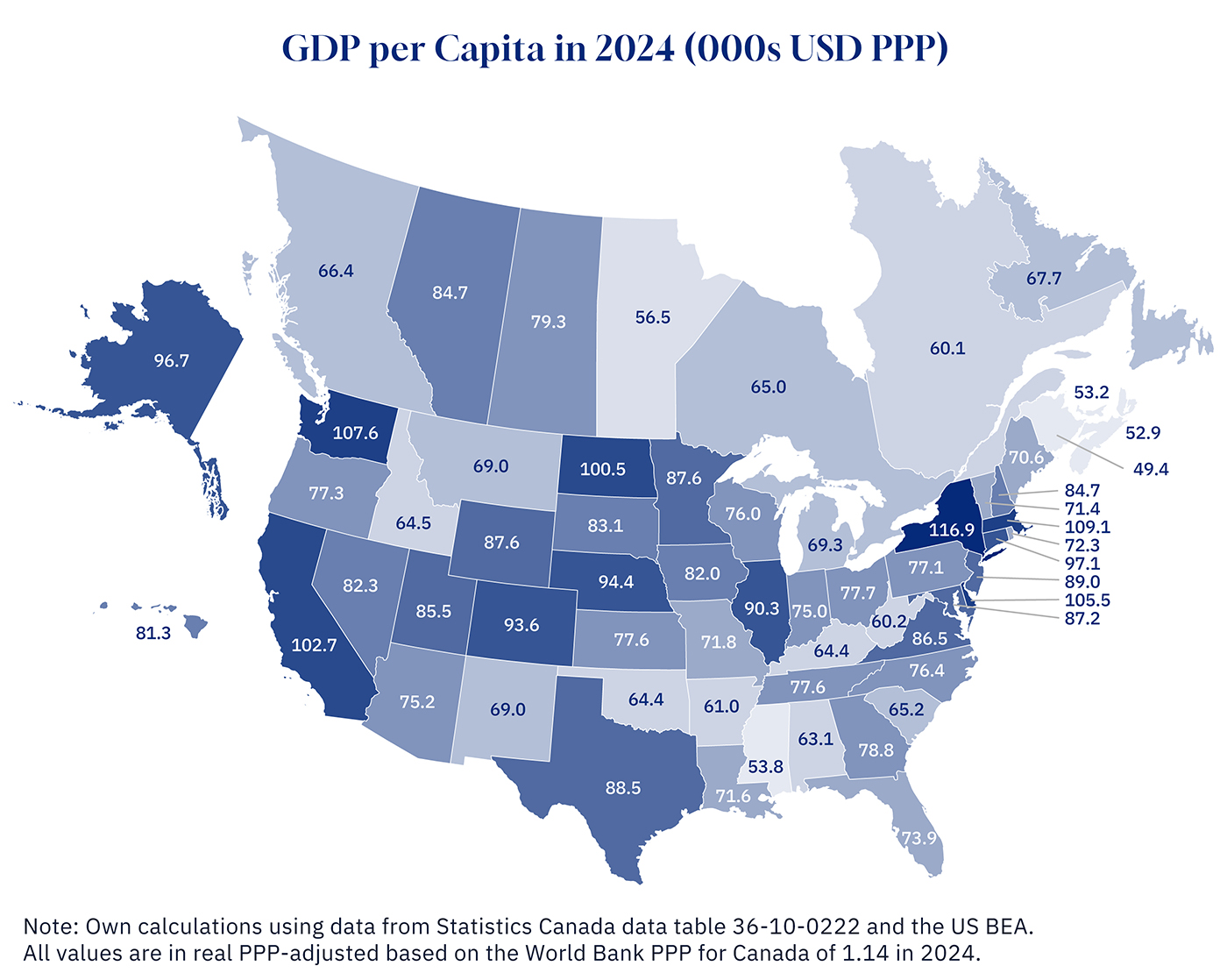The per capita purchasing power of most American states far exceeds that of Canadian provinces, with Ontario and Quebec ranking near the bottom of the list, well behind Tennessee, Georgia, Wyoming, and North Dakota.
Ontarians are poorer on average than Americans from 43 states, including those from New Mexico, Montana, South Carolina, Louisiana, Nebraska, and Missouri, according to new Statistics Canada data and the U.S. Bureau of Economics. The data was compiled by Hub contributor and University of Calgary economist Trevor Tombe, who looked at GDP per capita in 2024 for all states and provinces. Ontario ranked 48th out of the 60 states and provinces.
Tombe noted that some provinces are performing better than previous years, like Nova Scotia which surpassed New Brunswick, and Ontario [now surpassing] Alabama. Generally, however, U.S. states continue to outperform Canadian provinces in terms of productivity and overall wealth.
“I wouldn’t say Ontario’s all that much better off than it was before, but at least it’s kind of moved up relative to certain southern U.S. states,” Tombe told The Hub. “But for the most part, Canada still lags considerably behind almost every single other U.S. state. The lowest income regions in the whole continent here, excluding Mexico, are in Canada,” Tombe told The Hub.
Canada’s stagnant GDP growth led to a widening wealth gap between it and the U.S.
“In 2024, we saw on the whole an aggregate, the gap between Canada and the United States is [now] bigger than it has been since the Second World War,” Tombe added. “And so that’s reinforcing the need to really redouble efforts and to focus our attention on actually growing the economy for the long haul.”
The GDP per capita numbers were determined by calculating the total value of all services and goods produced in each state and province divided by each jurisdiction’s population, then adjusted for purchasing power parity (PPP), including the exchange rate into USD, cost of living, and pricing levels. The list included a total of 60 jurisdictions, representing 10 provinces and 50 states. The territories were not included.

The latest GDP per capita data shows Quebec ranked even worse than Ontario at 55th out of 60, below Alabama, Kentucky, Arkansas, and Oklahoma. Quebec was only wealthier than one state—Mississippi.
Another six Canadian provinces remain in the bottom 15 poorest jurisdictions of the U.S. and Canada. They include Newfoundland and Labrador (45th), B.C. (46th), Manitoba (56th), P.E.I. (58th), Nova Scotia (59th), and New Brunswick (60th).
The top three wealthiest jurisdictions in descending order were New York, Massachusetts, and Washington, with per capita GDP of US$116,900, $109,100, and $107,600, respectively. In comparison, B.C. ranked 46th, slightly higher than Ontario, at $66,400.
The GDP per capita in 2024 shows Ontarians with a per capita share of GDP at US$65,000, while those in Quebec and Manitoba lagged behind at $60,100 and $56,500, respectively.
As a new Fraser Institute study highlights, Canada’s productivity performance has trailed the U.S. over the past four decades, increasing 61 percent from 1981 to 2024. In contrast, U.S. productivity grew approximately 127 percent. In the last decade, Canada’s productivity languished, growing only 0.3 percent, in part due to the expansion and drop in productivity in our public sector workforce. The last time Canada’s productivity slightly outpaced America’s was the early 2000s. You have to go back to before the First World War, to see Canada and the U.S. productivity match one another for a sustained period of time.

There were a couple of bright spots for Canada, however, with two provinces in the top half of the list. Alberta ranked 20th overall at US$84,700, and Saskatchewan ranked 25th at $79,300. However, they both slipped several rungs from a couple of years ago when oil prices peaked.
“Alberta is now 20th, where it was previously last year, 17th, and Saskatchewan was previously last year, 19th, and now it’s 25th. So that’s kind of partly what’s dragging down the aggregate,” Tombe explained.
The economics professor believes that if provinces want to reverse their fortunes, their legislatures will need to take their fates into their own hands, and not rely on the federal government to solve the productivity problem.
“Big, big changes [are needed] to boost growth and investment. There’s a lot of focus on that federally, but the provinces have an enormous role to play there as well. And faster growth is the best way towards sustainable finances provincially,” Tombe said.
Why do you think Canadian provinces, particularly Ontario and Quebec, lag behind most US states in per capita purchasing power?
What role do you believe provincial governments should play in addressing Canada's economic lag compared to the US?
Given the data, what are some potential long-term economic consequences for Canada if this trend of lagging productivity and wealth continues?









Comments (8)
The plural of “anecdote” is not “data.”
This comes up when people visit Europe and get the impression about how wealthy the countries are they. But this is based on just going to the touristy areas of big cities, not to the countryside or the smaller cities. Ontario is huge and even though I have lived here over 60 years, there are vast areas I have never been. Those areas are not full of rich people.